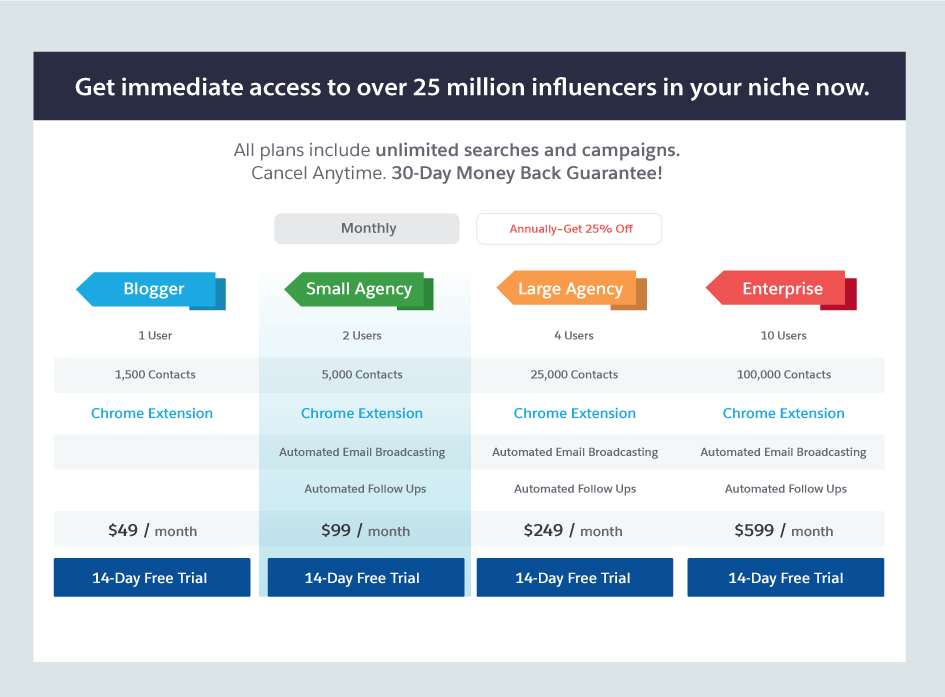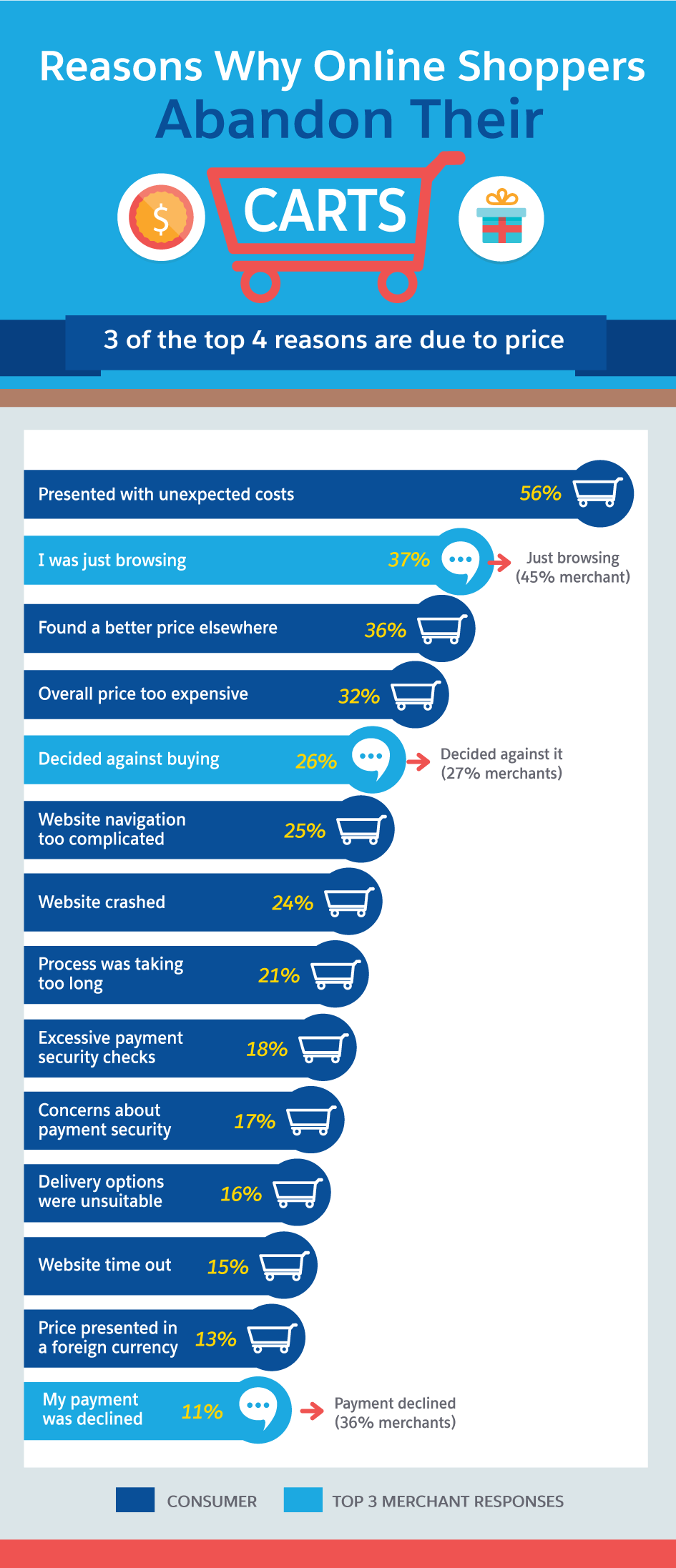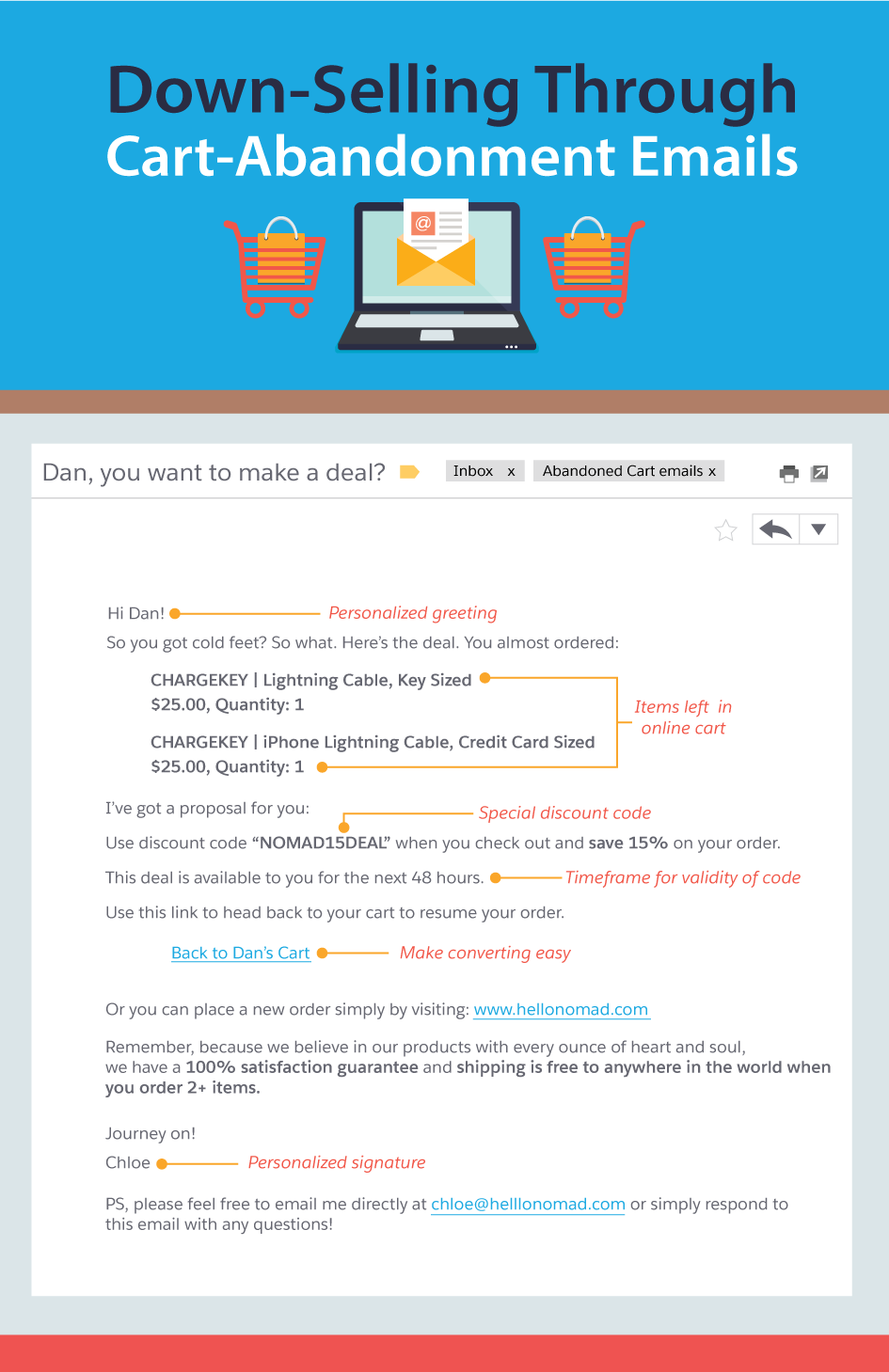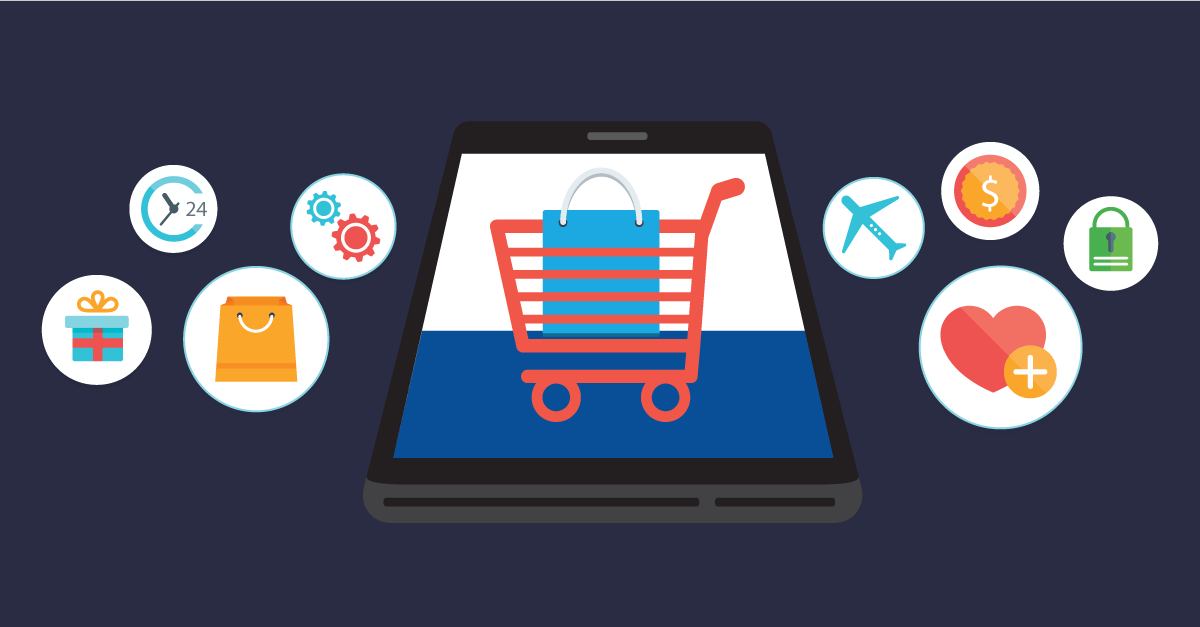You’re trying to make more sales, so you decide to cross-sell some items that might interest your customer. Maybe you intend to boost your revenue by recommending an item that’s superior and more expensive than the one your customer intends to buy. But have you considered addressing the concerns of budget-conscious customers?
Sometimes, a customer may decide to go for a more budget-friendly option even when it has fewer features and/or benefits. For this, the technique of down-selling comes in handy, yet many marketers fail to make the most of it.
What is down-selling and how does it work?
Down-selling is the technique of offering a more budget-friendly alternative to the product or service initially considered by the customer. It’s normally used when customers show a clear inclination toward refusing to make a purchase. When offered a this alternative, the customer may reconsider the purchase because you’re addressing a major objection—price.
While higher-priced items have a better profit margin, down-selling helps you close a sale even when the customer cannot afford to buy a premium product. That’s better than not making a sale at all. Offering a lower-priced alternative helps you build brand loyalty, too, as you show your customers you care about their budget constraints. You’ll also gain more exposure by selling your products to customers of varying budgets.
Down-selling is often recommended when your sales are dropping because your target market is unable to afford the products you sell. Slashing prices on your existing products may result in a huge loss for you. Instead, you can introduce a lower-priced item as an alternative for customers who need budget-friendly options.
Three Sales Techniques: Up-Selling, Down-Selling, and Cross-Selling
- Up-Selling
- Encourages customers to spend more money than they initially intended
- Usually consists of a recommendation of a product or service costing more than the one a customer is considering
- Benefits
- Higher regular order totals
- Exposure to higher margin product/service
- Increases in revenue
- Likely to improve customer satisfaction rates because you would be helping customers find products or services suited to their interests. Customers appreciate that you put in time and effort to understanding their wants and needs.
- Boosts customer lifetime value (CLV)
- How and when to use
- Display the savings of a bigger purchase
- Offer free delivery
- Down-Selling
- Involves making an offer of a product or service that's less expensive than the one a customer initially considered
- Benefits
- If a customer cannot afford a premium product, offering a lower-priced product is a great way to build brand loyalty
- You'll still make a sale even if the customer didn't purchase the item you'd originally wanted her to buy
- Allows you to access more clients with varying budgets
- How and when to use
- When you're certain the customer isn't going to buy the initial product or service offered
- Be careful to avoid introducing the lower-priced offer too early; doing so can confuse potential customers and cause them to decline both offers
- When customers are unable to afford certain products, that's an ideal time to introduce lower-priced items instead of slashing prices on more expensive ones
- When you down-sell, your intent should be to up-sell in the future
- Cross-Selling
- Used to encourage customers to buy products or services that aren't directly related to the initial item purchased
- Retailers that use cross-selling often display recommended products or services that were purchased by other customers who bought the same item
- Introduces customers to complementary products
- Benefits
- Increase conversion rates
- Build customer equity
- Helps differentiate your brand from your competitors and improve your market position
- Enhances customer loyalty
- Deepens attachment to your business
- How and when to use
- One effective tactics is bundling and saving packs—increases the sale value
- Recommend to your customers which other purchases were made by those who bought a similar product
- Allow customers to personalize bundles by selecting the exact products they want

How to down-sell effectively for boosting conversions
You understand the concept of down-selling, but you may be unsure how to apply it to your own marketing strategy. Since other selling techniques like cross-selling and up-selling are so common, many marketers miss out on the opportunity to make more sales with down-selling. This means you may not see too many examples of down-selling applied in real life. Here are a few ideas that will help:
Use Exit-Intent Pop-Ups
Have you visited a website and received a popup offering a discount just as you’re about to leave? That’s called an exit-intent pop-up. It monitors the activity of website visitors, and once the visitor starts making a move to close the tab, it comes up with an attractive offer that could entice them to stay longer. The offer may be anything from discounts to newsletter sign-ups, but you can modify it according to your needs.
Discounts are a popular down-selling technique, but they could result in a huge loss despite the higher number of sales. The idea behind using exit-intent pop-ups for down-selling is that you can selectively choose which people see the discount, instead of giving it to every person who visits your site. After all, some people may want to buy your products even without the discount. This means you’ll only target individuals who are planning to leave your site, in the hopes they’ll take the offer and turn into a paying customer.
How do you know if exit-intent pop-ups work? Several case studies prove that these pop-ups helped websites increase sales and sign-ups. While some websites offered discounts, others offered free eBooks or consultations. So the offer can be customized according to what you need and what your customers would like. Neil Patel, for instance, uses an exit-intent pop-up offering a free cheat sheet for online marketing.
Before implementing exit-intent pop-ups, ensure you target visitors who seem to be truly interested in the product. When monitoring their activity, make sure you look for people who spend some time on your website and check out various features and pricing information. You can filter even further by displaying the pop-up when they intend to leave even with items in their cart.
Create a Value Package
As previously mentioned, offering discounts for your existing products may not be the most viable down-selling solution. If that’s the case, you may want to create a package that costs slightly less than your existing ones. This works especially well for SaaS companies and businesses in the service industry, as you can easily customize the packages by removing certain features for the budget-friendly package.
Scott Hallman produced case studies about the effectiveness of down-selling with value-based packages: By creating a lower-cost coaching service and training program, his company experienced a 125 per cent increase in conversion rate in the first month alone. This is an excellent technique to reach out to potential customers who were previously unable to buy your products because of budget constraints. You’re making the product more accessible for them and encouraging them to make a purchase.
If you’re worried about too many customers going for the value-priced item, highlight the package that yields the highest revenue for you. When visitors land on the pricing page, make sure the high-revenue package is the most prominent and the low-cost package is just another option. You can show them that the high-revenue item is “Recommended” or the “Best Deal,” prompting people to select it. If they can’t afford it, they still have the option of going for the low-cost option.
In an example from Ninja Outreach, the “Small Agency” package is highlighted and also displays how people get 25 per cent off on the annual cost by choosing that package. But there is a more budget-friendly option as well: the “Blogger” package. The features of each package are clearly displayed, showing customers exactly what they get with each option.

Send Cart Abandonment Emails
A study conducted by the Baymard Institute found that the average shopping cart abandonment rate is 68.63 per cent. This suggests that even you may have plenty of customers abandoning their shopping carts. But why? While it may be subjective for every customer, there could be a few common reasons behind it.
According to WorldPay, being presented with unexpected costs is the biggest reason why people abandon their shopping carts; 56 per cent citing this reason. Thirty-six per cent abandoned their carts because they found a better price somewhere else, and 32 per cent said that it was because the overall price was too expensive.
Reasons Why Online Shoppers Abandon Their Carts
3 of the top 4 reasons are due to price
- 56% Presented with unexpected costs
- 37% I was just browsing (just browsing 45% merchant)
- 36% Found a better price elsewhere
- 32% Overrall price too expensive
- 26% Decided against buying (Decided against it 27% merchants)
- 25% Website navigation too complicated
- 24% Website crashed
- 21% Process was taking too long
- 18% Excessive payment security checks
- 17% Concerns about payment security
- 16% Delivery options were unsuitable
- 15% Website time out
- 13% Price presented in foreign currency
- 11% My payment was declined (payment declined 36% merchants)

This shows that pricing is one of the biggest reasons why people abandon their shopping carts. So how can you convince these customers to convert? Down-selling by offering discounts is one of the best techniques to turn abandoned carts into actual purchases.
There are a few ways to implement discounts for customers who abandon their shopping carts. You can display exit-intent pop-ups when customers move to exit the page, despite having items in their cart. But what if they’re just exiting the page to do something else, and they fully intend to come back later and make that purchase? Instead of immediately offering a discount to these customers, some marketers wait, then send out cart abandonment mails instead if the customer doesn’t show signs of coming back to close the sale.
Instead of just sending a reminder about an abandoned cart item, sweeten the deal with an exclusive discount. Make sure the discount has a time limit and you provide an easy method for the customer to complete the purchase.
Take a look at the cart abandonment email Dan Wang of Shopify received. The email mentions the items left in the cart, provides a special discount code, and gives a timeframe for the validity of the code.
Down-Selling Through Cart-Abandonment Emails

Offer Multiple Buying Choices
For ecommerce websites selling products through different vendors, offering multiple buying choices for the same item is an excellent down-selling technique. As mentioned in the third point, highlight the choice that gives you the highest revenue, but also provide budget-friendly options for those looking to save a few bucks on the purchase.
Customers may not care to look at the other options when they really want a product: They’ll simply go forward with the high-revenue option that you’ve highlighted. But you’ll still be providing budget-conscious shoppers with other choices that cost less than the best-revenue item. This means you’ll end up making a sale either way.
For example, Amazon is well-known for its ability to execute successful cross-selling and up-selling techniques on its product page. It displays what items are frequently bought together and which products were bought by customers who bought the specific item you’re looking at. By making the product recommendations relevant, they improve their chances of making more sales.
Even with their down-selling techniques, Amazon has it down to a science. This is especially prominent in its book section, as shoppers have multiple options to buy different versions of the same book. Amazon normally highlights the pricing for the paperback version, but also gives the pricing for the hardcover, Kindle, and audible versions for the book.
If you look closely at the list beneath “Paperback” and “Hardcover,” Amazon gives more buying choices for shoppers. There are budget-friendly choices in both used and new books. But you won’t notice these options unless you’re actively looking for the lowest-priced choice.
What to avoid when down-selling
You have some great ideas on how to down-sell and you know how effective it can be. But there are a few mistakes you might make when applying this technique. While the ideas mentioned above can be effective, some customers may end up taking advantage once they figure out what you’re doing. And in some cases, you may end up incurring losses in the process of providing too many discounts.
Here are two things you need to avoid when you’re applying down-selling techniques in your marketing strategy:
- Don’t overdo it.
Unlike cross-selling and up-selling techniques, down-selling is riskier, and you may regret it if you do it too much. Imagine visiting a website that gives you discount pop-ups every time you try to leave. Savvy customers would keep coming back only to get the discount code. Additionally, some customers may undervalue your products if you offer them discounts whenever they abandon their shopping cart.
- Don’t target each and every visitor.
Since it’s important to avoid overdoing it when you’re down-selling, focus on visitors who seem genuinely interested in buying your products. It’s best to make use of a software that will let you monitor visitor behaviour, such as time spent on your site, areas clicked, time spent on a certain page, and more.
Look for visitors who spend a significant amount of time on your site, browse several pages, and spend some time on the pricing page. This could suggest they are interested in the product and took the time to study the features, but contemplated the pricing. Down-selling to these potential customers could be more profitable than down-selling to each and every website visitor.
What’s next?
Now you have some of the most effective and useful ideas, along with tips on what to avoid when you’re down-selling. Make sure you avoid relying on this technique alone and make use of other methods like cross-selling and up-selling to increase conversions and maximize your revenue.
Share "4 Ways To Boost Conversions Through Down-Selling Techniques" On Your Site




